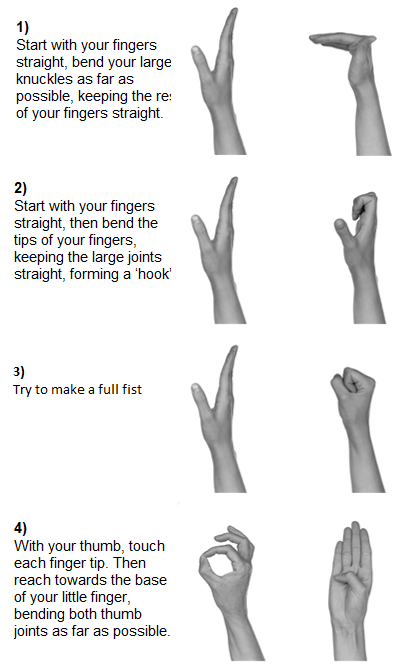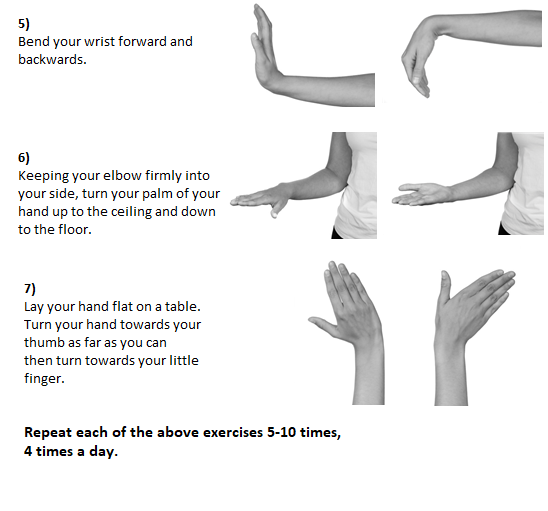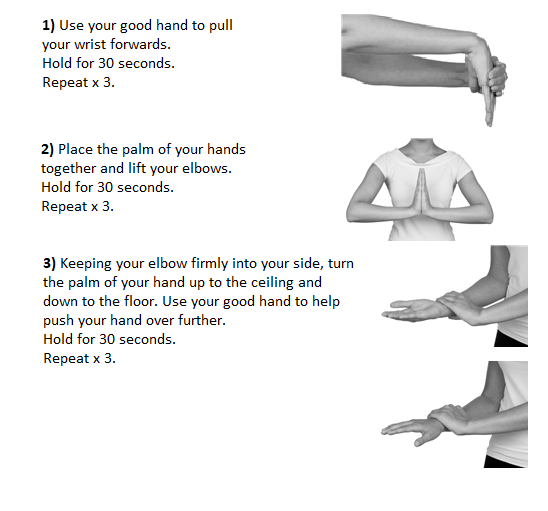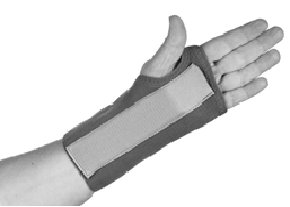Fractured Wrist - OUT OF CAST
To view this as a pdf; Click here.
Your doctor is now happy with the healing of your wrist following your injury, and your cast has now been removed. Gradually resume normal activities as pain allows. The following advice will help you return to your normal activities.
Immediately following the removal of your plaster
You might find that your wrist is stiff, swollen and your skin is dry and flaky, this is normal. To help (as long as you do not have an open wound) soak your wrist in a bowl of warm water. For maximum effect soak your wrist for 15 minutes every 2 hours. Remember that following removal of your plaster your skin sensation may not be as good, so check the temperature of the water with your good hand first. Massaging a non-scented moisturising cream into your skin may also help.
Exercises
It is now essential to start to exercise your wrist and hand to prevent further stiffness and weakness. It will also help you to return to your normal activities.
Continue with the finger exercises you have already been doing in the cast along with the wrist exercises. These are shown on the following pages.


If you are finding it difficult to regain your wrist movement with the above exercises after 2 weeks, then try the exercises below (4 times a day). It is okay to start to put some pressure through your wrist using your opposite hand.

General
It is important that you start to use your wrist for light activities, steadily building up the use and progressing to more demanding activities. It may be some weeks before full strength returns.
Your wrist will be healing while you are doing your rehabilitation exercises. To further help the healing process it is important that you have a well balanced diet and you do not smoke.
If your wrist is resting in a bent position or your pain is not settling, you may find a soft wrist support, such as the one in the picture, may help to provide some protection. Your local Pharmacist may be able to supply a support if needed, or you may choose to order online. Try to use this only for the first 2 weeks after your cast is removed.

Gradually resume normal activities as pain allows, including light tasks and driving. However, heavier tasks or sporting activity may still cause discomfort, and it is advisable to resume these 12 weeks following your injury. Symptoms will continue to improve over the next few months. Some mild symptoms, such as occasional pain and stiffness can persist for 6-9 months. If you are still experiencing significant pain and/or stiffness please contact fracture clinic for further advice/management.
Driving
Unless your doctor has said otherwise your wrist fracture has healed enough to allow you to drive without further injury. However, whether you are safe to drive is your decision and not your doctor’s. It is advisable to test yourself in a stationary car first. Check that you have enough strength and range of motion in your wrist to be in full control of the car. When making this decision you must take a common sense approach and remember you have a duty of care to other road users.
For those returning to sport
Return to sport or demanding activities will be determined by how soon your wrist recovers, not by how many day or weeks it has been since your injury occurred. You can return to sport safely when each of th following is true or as advised by your doctor or physiotherapist.
Recreational sports (for example golf, bowls)
- You have 3/4 to full range of motion in your wrist compared to the other wrist.
- Your wrist is strong enough to handle the demands of the activity safely.
Competitive/contact sports (for example rugby)
- You have been out of your cast for as long as you were in it. For example, 6 weeks wearing a cast equals 12 weeks before returning to sport.
- You have full range of motion at your wrist joint compared to the uninjured wrist.
- You can lean your body weight through your hand without any pain.
- Swimming and running can be resumed earlier if you are keen on keeping fit.
If your wrist pain is severely increased, please contact Fracture Clinic at Neath Port Talbot Hospital for advice on 01639 507331.
If you are having problems regaining your movement and function with these exercises and advice, please contact the Physiotherapy department on 01792 487453 (Monday to Friday 8:30-13:00)
Please note: We are in the process of updating our website. The Welsh language is important to us and we are currently translating our content. Thank you for your patience. Ry'n ni'n y broses o ddiweddaru ein gwefan. Mae'r Gymraeg yn bwysig i ni ac ry'n ni wrthi ar hyn o bryd yn cyfieithu ein cynnwys. Diolch i chi am fod yn amyneddgar.
Rydym yn croesawu gohebiaeth a galwadau ffôn yn y Gymraeg neu'r Saesneg. Atebir gohebiaeth Gymraeg yn y Gymraeg, ac ni fydd hyn yn arwain at oedi. Mae’r dudalen hon ar gael yn Gymraeg drwy bwyso’r botwm ar y dde ar frig y dudalen.
We welcome correspondence and telephone calls in Welsh or English. Welsh language correspondence will be replied to in Welsh, and this will not lead to a delay. This page is available in Welsh by clicking ‘Cymraeg’ at the top right of this page.